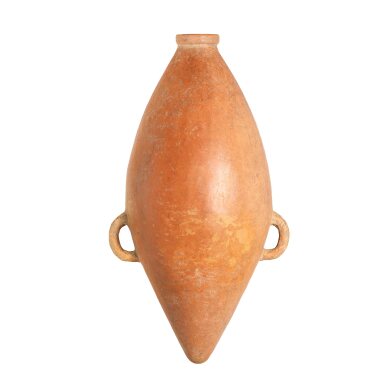
Property from the Ronald W. Longsdorf Collection | Ronald W. Longsdorf 收藏
A red pottery taper-end flask Yangshao culture, Banpo phase, c. 4800-4300 B.C. 仰韶文化 半坡類型 紅陶尖底瓶
Auction Closed
May 25, 03:26 AM GMT
Estimate
60,000 - 80,000 HKD
Lot Details
Description
Property from the Ronald W. Longsdorf Collection
A red pottery taper-end flask
Yangshao culture, Banpo phase, c. 4800-4300 B.C.
Ronald W. Longsdorf 收藏
仰韶文化 半坡類型 紅陶尖底瓶
49.5 cm
Ronald W. Longsdorf, The Pottery Age: An Appreciation of Neolithic Ceramics from China, Circa 7000 BC - Circa 1000 BC, Hong Kong, 2020, pl. 4.
Ronald W. Longsdorf, 《陶誌:中國新石器時代陶器 約公元前7000年 – 前1000年》,香港,2020年,圖版4
Such taper-end flask is a classic shape to the Banpo phase in the Yangshao culture and exist in various different sizes. The present flask, with its elegant form and beautifully burnished patina, ranks among one of the finest example of its type.
These flasks were used as water containers, they were suspended in water via cords tied around the neck and the loop handles. The mechanism of filling water into the vessel is ingeniously dependent on the varying centre of gravity attained as the top-heavy empty flask is gradually filled with water. With their substantial volume intake, these flasks were believed to function as water storage to minimise burdensome refills, especially when water source is not in proximity to the community.
A recent study discovered shards of a bottle of this form with residues of grains used in beer fermentation and a Banpo phase red pottery funnel which could have been used to fill these flasks, pointing that such flasks could be used as both water and fermented alcohol containers.
Compare a similar example without handles from the Meiyintang collection, illustrated in Regina Krahl, Chinese Ceramics from the Meiyintang Collection, Vol. III, 2006, p. 13, no. 1021; and a painted example in Zhu Yongnian, Neolithic pottery of Northwest China, Shanghai, 2007, p. 52, fig. 42.
You May Also Like





